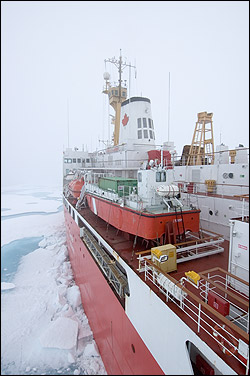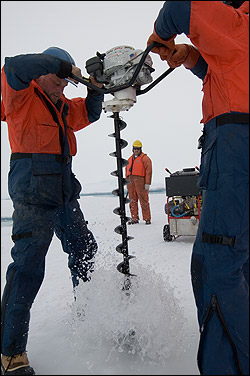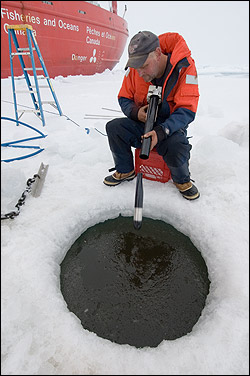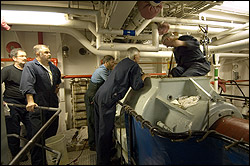Please note: You are viewing
the unstyled version of this website. Either your browser does not support CSS
(cascading style sheets) or it has been disabled. Skip
navigation.
Chris LinderAugust 19, 2005
This morning Captain Potts met with Sarah and the WHOI mooring team to discuss whether or not it would be possible to deploy the next set of ice camp buoys near the ship. Unfortunately, we are now restricted to ice floes that are within sight of the ship, because one of the Louis' major assets, the helicopter, was grounded yesterday because of engine problems. Our options were quite limited, however--even though we are in multi-year ice, the ship has cracked most of the nearby floes, and melt ponds and leads separate us from the most promising ice. After a quick scan of the surrounding area, it was decided that we would have to wait to deploy them at a better location. Our third problem isn't as serious as the others, but it is an annoyance nonetheless. Because of the way the ship is positioned, our antenna for sending and receiving email is blocked until we can reposition... which of course can't be done until the engine repairs are complete. The sudden series of difficulties made Rick Krishfield speculate that we have wandered into the "Beaufort Triangle"--a region similar to the legendary Bermuda Triangle where ships and aircraft experienced mysterious problems. One thing that isn't broken, however, is our spirits. After lunch, the mooring group used the ice alongside the ship to test a completely new setup for melting large diameter holes in the ice. The equipment was going to be used to recover the ice buoy that disappeared at the beginning of the month. Since we never did find those buoys, John was itching to see if the setup would work. So, a small group of us (John, Kris, Seaman Neil Jollymore, and myself) were lowered over the side of the ship by the crane in the "man basket." John and Kris then used the auger (see second photo from the top) to drill a preliminary hole. They then set up a small generator, the melter (a machine that heats seawater), and a stainless steel cage that directs the heated water into a circular pattern in the ice. They then erected the gantry used for the buoy deployments and hauled the perfectly cylindrical ice core out of the hole. John and Kris were ecstatic that the equipment worked so well. Incidentally, the hole in the ice was just big enough for XCTD launches. Masuo Hosono was happy to collect some data today. The Beaufort Triangle may slow us down, but we're fighting back. When we returned to the ship, I made a trip down to the engine compartment to check on how the repairs were going. Engineer Larry Colbert showed me the enormous shafts that drive the propellers. He was pretty optimistic about the repairs. He told me that they made some great progress today finding the source of the problem, but it would take several days to nurse the shaft back to health. Although the ship can function using two of the three propellers, our icebreaking capability would be severely limited and we would most likely be forced to make our way directly home. All of our hopes are with the engineers and oilers working down below. Even though our problems are disappointing, it is something you have to be prepared for when you're studying one of the harshest, most isolated places in the world. We have already accomplished a tremendous amount under severe ice conditions. Stay tuned to this site to see whether or not we can break the curse of the Beaufort Triangle. Last updated: October 7, 2019 | ||||||||||||||||||||||
Copyright ©2007 Woods Hole Oceanographic Institution, All Rights Reserved, Privacy Policy. | ||||||||||||||||||||||






